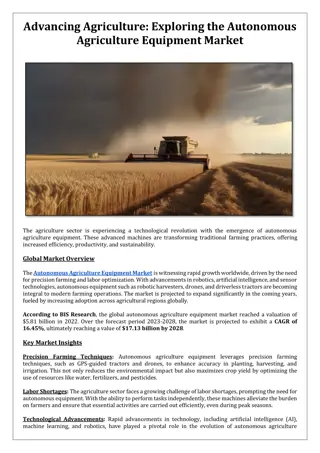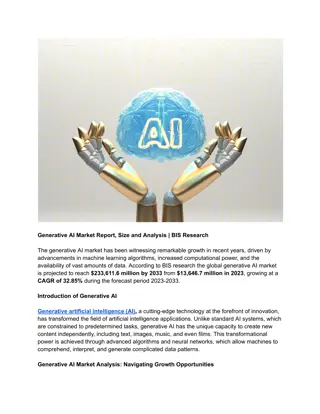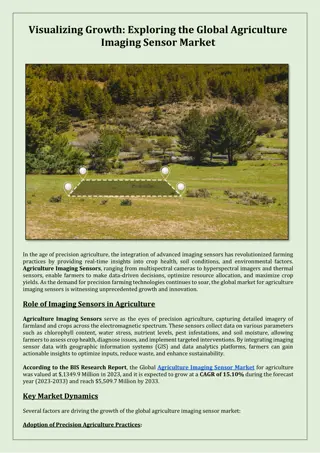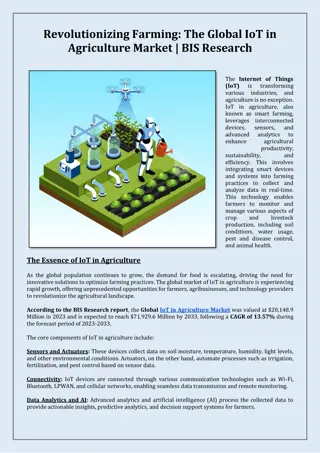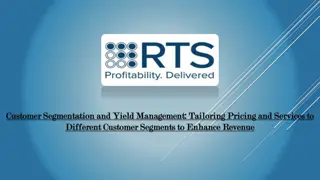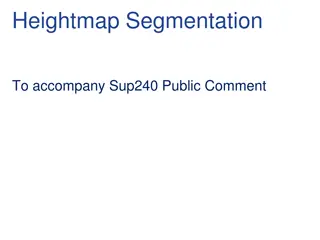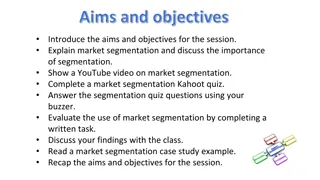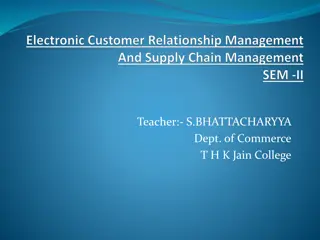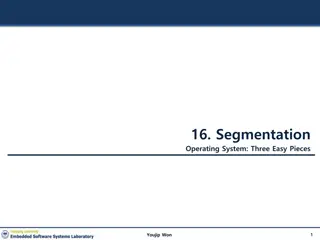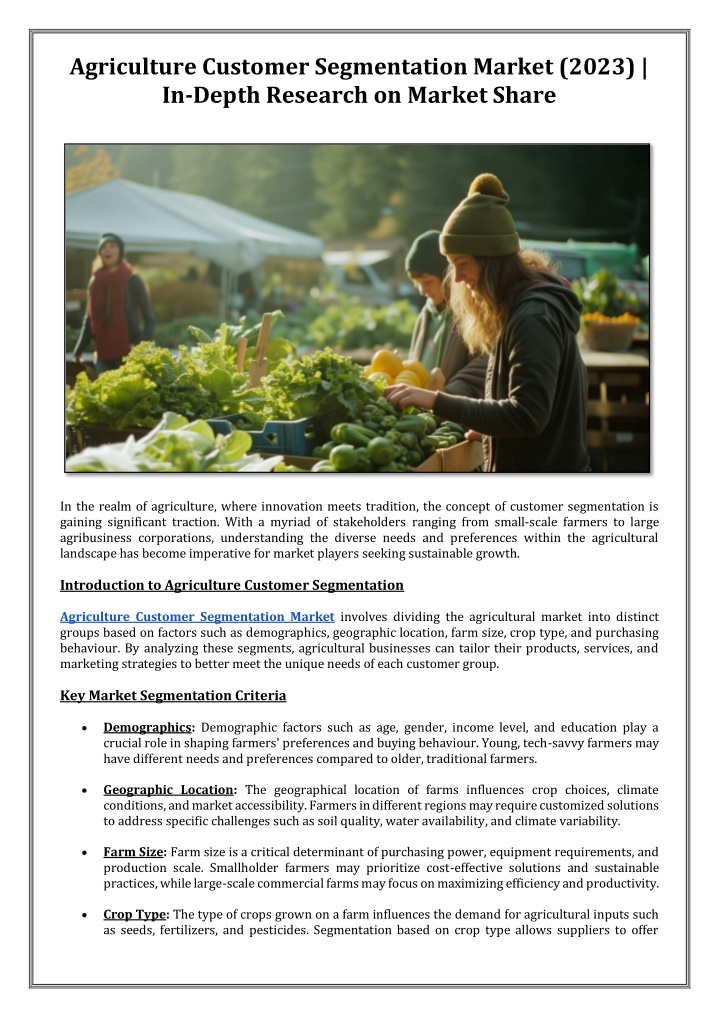
Agriculture Customer Segmentation Market (2023) | BIS Research
Agriculture Customer Segmentation Market involves dividing the agricultural market into distinct groups based on factors such as demographics, geographic location, farm size, crop type, and purchasing behavior. By analyzing these segments, agricultural businesses can tailor their products, services, and marketing strategies to better meet the unique needs of each customer group.
Uploaded on | 17 Views
Download Presentation

Please find below an Image/Link to download the presentation.
The content on the website is provided AS IS for your information and personal use only. It may not be sold, licensed, or shared on other websites without obtaining consent from the author. If you encounter any issues during the download, it is possible that the publisher has removed the file from their server.
You are allowed to download the files provided on this website for personal or commercial use, subject to the condition that they are used lawfully. All files are the property of their respective owners.
The content on the website is provided AS IS for your information and personal use only. It may not be sold, licensed, or shared on other websites without obtaining consent from the author.
E N D
Presentation Transcript
Agriculture Customer Segmentation Market (2023) | In-Depth Research on Market Share In the realm of agriculture, where innovation meets tradition, the concept of customer segmentation is gaining significant traction. With a myriad of stakeholders ranging from small-scale farmers to large agribusiness corporations, understanding the diverse needs and preferences within the agricultural landscape has become imperative for market players seeking sustainable growth. Introduction to Agriculture Customer Segmentation Agriculture Customer Segmentation Market involves dividing the agricultural market into distinct groups based on factors such as demographics, geographic location, farm size, crop type, and purchasing behaviour. By analyzing these segments, agricultural businesses can tailor their products, services, and marketing strategies to better meet the unique needs of each customer group. Key Market Segmentation Criteria Demographics: Demographic factors such as age, gender, income level, and education play a crucial role in shaping farmers' preferences and buying behaviour. Young, tech-savvy farmers may have different needs and preferences compared to older, traditional farmers. Geographic Location: The geographical location of farms influences crop choices, climate conditions, and market accessibility. Farmers in different regions may require customized solutions to address specific challenges such as soil quality, water availability, and climate variability. Farm Size: Farm size is a critical determinant of purchasing power, equipment requirements, and production scale. Smallholder farmers may prioritize cost-effective solutions and sustainable practices, while large-scale commercial farms may focus on maximizing efficiency and productivity. Crop Type: The type of crops grown on a farm influences the demand for agricultural inputs such as seeds, fertilizers, and pesticides. Segmentation based on crop type allows suppliers to offer
tailored solutions that address the unique needs of different crop categories, whether it's row crops, fruits, vegetables, or specialty crops. Purchasing Behaviour: Understanding farmers' purchasing behaviour, preferences, and decision- making processes is essential for effective segmentation. Factors such as brand loyalty, price sensitivity, and willingness to adopt new technologies influence farmers' buying decisions and product preferences. Access More: Download FREE Sample Report (Pdf) on Agriculture Customer Segmentation Market Research. Benefits of Agriculture Customer Segmentation Targeted Marketing: Segmentation enables agricultural businesses to create targeted marketing campaigns that resonate with specific customer groups. By tailoring messages and promotions to the needs and preferences of different segments, companies can improve the effectiveness of their marketing efforts and drive customer engagement. Product Customization: Segmentation allows businesses to develop customized products and services that address the unique requirements of different customer segments. Whether it's offering specialized crop protection solutions or precision farming technologies, customization enhances customer satisfaction and loyalty. Improved Customer Experience: By understanding the distinct needs and challenges faced by different customer segments, agricultural businesses can provide personalized support and assistance. Whether through technical advice, training programs, or after-sales service, enhancing the customer experience fosters long-term relationships and brand loyalty. Market Expansion: Segmentation enables businesses to identify underserved or niche markets that present growth opportunities. By catering to the specific needs of these segments, companies can expand their market presence and diversify their revenue streams. Market Challenges and Considerations Despite its benefits, agriculture customer segmentation poses several challenges, including: Data Collection: Gathering accurate and comprehensive data on farmers' demographics, preferences, and behaviours can be challenging due to factors such as limited connectivity, language barriers, and data privacy concerns. Segmentation Accuracy: Developing meaningful and actionable segments requires robust data analytics capabilities and sophisticated segmentation models. Ensuring the accuracy and relevance of segmentation criteria is essential for effective targeting and positioning strategies. Dynamic Nature of Agriculture: The agricultural landscape is constantly evolving due to factors such as technological advancements, climate change, and market dynamics. Adapting segmentation strategies to reflect these changes requires agility, flexibility, and continuous market monitoring. Conclusion In an increasingly complex and dynamic agricultural market, customer segmentation emerges as a strategic imperative for businesses seeking to thrive amidst competition and uncertainty. By understanding the diverse needs and preferences of farmers, agriculture companies can unlock new opportunities, drive innovation, and foster sustainable growth in the evolving landscape of modern agriculture.


